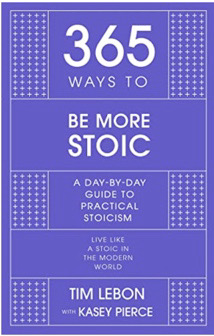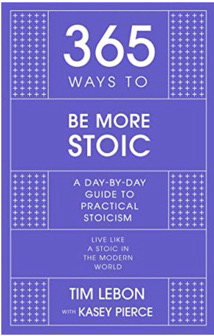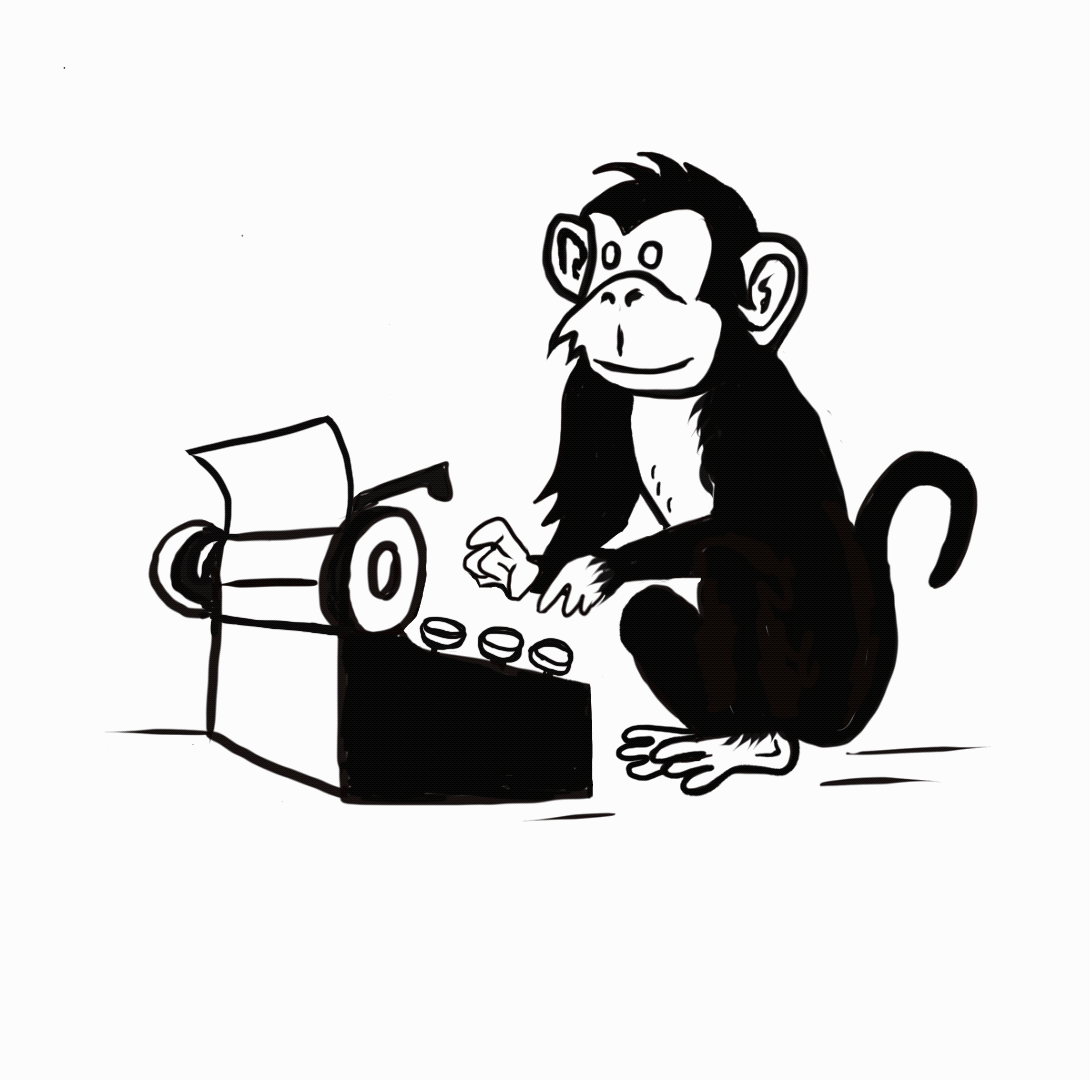This time on the hot seat: Kasey Pierce! Kasey is an author, editor and Stoic. She is the editor of Tim Lebon’s upcoming book, “365 Ways To Be More Stoic.” Preorder here: https://smile.amazon.com/Ways-More-Stoic-day-day-ebook/dp/B0B1ZR3XMK/

What led you to embrace Stoic philosophy?
Many reasons, but the leading one being freedom from paralyzing, irrational fear.
I’ve unconsciously used Stoic principles to keep moving forward in life. Many of us feel “stuck” at one time or another and blame it on circumstance. Although circumstance can play a factor, I believe that if someone is bound and determined not to stay in one place, present circumstances go from endless to temporary. Nine times out of ten, the next steps are clear, but our fear of discomfort keeps us from taking initiative.
Think about that, though… Almost every lack of initiative, from changing jobs to ending a toxic relationship, simply boils down to the fear of discomfort. That’s it.
Could you imagine if we thought about that each time a decision needed to be made? If we could time travel to a year or even a few months post decision, we would probably feel a great sense of relief. In fact, for better or worse, we would feel a sense of pride from having the courage to make such a decision. Because even if the decision somehow doesn’t provide the satisfaction we thought it might, in the grand scheme, a grand majority of the time, we will still be okay. It isn’t the end or anything we cannot bounce back from.
Now, imagine another year of having not made any decision and still feeling “stuck”. Wouldn’t that simply drag out your current discomfort? I mean, either way, you have decided to stay or move on. If stagnation is death and new beginnings are…well…new beginnings, then isn’t that a life-or-death decision? Food for thought.
A good question to ask is what makes a decision “good” or “bad”? As Epictetus so famously put it, “It isn’t events that disturb us but rather our judgements about them.”
Is the difference between a “good” and “bad” decision really based on the level of satisfaction the result brings? If we could release this white-knuckled grip we have on the outcome, it could mean turning disappointment into opportunity. Making decisions shows us our strengths, weaknesses, and even helps us identify our preferences.
Zeno, the founder of Stoicism, was a wealthy merchant who lost his valuable wares in a shipwreck. With nothing to gain or lose, he wandered into a bookshop and came upon a book by Xenophon. His depiction of Socrates inspired Zeno, and he wanted to know where he could find more men like him. The shopkeeper pointed at Crates, a Cynic, who happened to be walking by. From then on, Zeno became his student and eventually formed his own branch of philosophy (which became Stoicism) and lectured in the ancient Agora of Athens. He had to let go of what was lost, the uncontrollable incident, to be receptive to a new and wonderful opportunity.
Discomfort comes in many forms, from uncertainty to feeling like we’re letting someone else down to worrying that we may make the wrong decision. The good news is just because you feel a certain way doesn’t make it true. (I’m tickled every time I say that because what a relief!)
Of course, the most popular misconception about Stoicism is that it means being void of feelings. It isn’t that at all. It’s about putting reserves in the tank for the emotions that matter most, like joy and a zest for life. Negative emotions shouldn’t be avoided but rather analyzed. Take fear, for example. We should be emotionally aware enough to separate rational fear from irrational fear. One of the most obvious examples of rational fear I can give is making sure you haven’t left a candle burning when you’ve left the house. What makes this fear rational is that it has evidence to back it up. Some houses have been set ablaze by such negligence.
Irrational fear, however, is not survival-based normally and is often referred to as “anxiety.” This is when we accept our initial impressions as facts (e.g., our lover is losing interest because they haven’t texted back). Irrational fears can direct the course of our life if we’re not careful to assess them. Taking what the Stoics call “the view from above”, desaturating the strong feelings of paranoia or heartbreak etc., allow us to view the situation in its entirety. Suddenly, a bird’s eye view shows us that a mountain really is but a molehill.
As a writer and editor, what role does Stoicism play in your creative process?
“Short-lived are both the praiser and the praised.” –Marcus Aurelius
A writer can either be a hobbyist or a professional. Neither is wrong but the writer must decide early on. However, if they’ve decided they want to be a part of this industry, and they are determined to stay, flattery will get them nowhere.
Professional writing is a very vulnerable field. Your work is out there and it will be praised or pissed on, but neither matter. What matters is your level of resilience and willingness to transform.
When I was doing a signing for my first published book, a young man came to the table and said he’d found my book in a coffee shop. He was an avid indie horror fan and expressed that he liked the book. The editor for what would be my next book, Travis McIntire, was seated next to me and so I introduced him. The man suddenly became very rude and uppity, triggered at the word “editor”. He went off on a strange tangent about how editors are “bastardizing the industry” because they “change the writer’s words”—stifling them or some such. Of course, this man was not a professional writer himself but a hobbyist with the wrong impression.
Travis kept his cool, however, and took this as an opportunity to educate this young man on what an editor’s role really is. The man wasn’t having it, though, and I was ready to throw hands (not a Stoic moment for me). This story segues into a perfect opportunity to clear up any misconceptions about an editor’s role (now that I am one)…
An editor (one like me anyway) is a seeker of opportunities for a writer to expand on their topic. We also seek out areas that take the reader on unnecessary detours, trimming back content that may have taken them on a scenic route away from the original point. In other words, we’re here to make sure your message is perceived the way it was intended to be perceived. We’re the ones that lint roll and straighten the back of your jacket before you walk out on stage, making sure you look good. At times, we may provide some original content (which was the case for 365 Ways…). That is on a writer-allotted basis, though.
However, we are not here to praise you. We are also not here to berate you. We are here to make you better, to get you in touch with your inner daemon—the best writer you can be. We are indifferent to the idea of positive or negative feedback. To a professional editor, it is viewed simply as constructive feedback. That can only come from the conditioning the editing process provides. It may hurt at first, but it will only continue to hurt you if you let it. They call them “growing pains” for a reason.
Your new book with Tim Le Bon is titled “365 Ways To Be More Stoic.” Why did you choose that format? Also, what does an aspiring Stoic do in leap years?
CBT therapist Tim Lebon was inspired by the self-help classic “Don’t Sweat the Small Stuff”; a book I read shortly after I graduated high school. He wanted to create a book that went beyond a daily devotional filled with motivational quotes. He understood that if one is striving to adopt a whole new framework to their outlook, it’s something that should be practiced daily. This is why every few entries contain a CBT exercise for the reader. Stoicism is the foundation of CBT (Cognitive Behavioral Therapy).
An aspiring Stoic should take that extra day in a leap year to reflect on what life was like before Stoicism. They should measure their level of stress, happiness, and observe how they react to situations now vs. then. They should also gift a copy of 365 Ways to Be More Stoic to a friend.
Stoicism is sometimes referred to as “broicism,” because it’s been embraced by a lot of men. Why is Stoicism relevant to women as well as men?
So, I was telling my husband the other day that I may have this figured out…
Men who don’t like the idea of women in Stoicism usually take issue because they don’t like any “woo-woo” thrown in the mix. I use “woo-woo” to describe practices that are seen as metaphysical, mystic, spiritual etc. Maybe I’m wrong but I have seen that before, women striving to make these worlds collide. I’m here to tell you that I practice transcendental meditation, hug trees, and might have some tarot decks but it doesn’t have anything to do with Stoicism.
However, let us not forget that Marcus was initiated into the cult of Demeter and Persephone by way of secret religious rite. Even Cicero, a skeptic, described the faith as a way of “dying with better hope”. There are many references to death as the reaping of corn, a nod to Demeter. Many Stoics also practice “death meditation” and the cognitive rehearsal of loss, me included. So, it isn’t fair for anyone to say there’s no place for mysticism in Stoicism. The difference is when the philosophy feels shoehorned.
I once read a comment that said, “Women cannot be Stoic because their intense emotions are innate to protect their children.” So…if someone tries to attack a child, the Stoic male father won’t have an intense reaction? As I said, the most popular misconception about Stoicism is that it means being emotionless. It does not mean that at all. It’s the practice of not accepting initial impressions and indulging in emotions that don’t serve.
Appropriately motivated anger serves in survival situations. When I say motivated anger, I can best describe it as compared to the aforementioned rational vs. irrational anxiety. Rational anxiety is an innate feeling utilized for survival. This would kick in (I would hope) for any gender when it comes to their children. You would watch your kids, for instance, like a hawk when they’re on the playground because they’re liable to wander off or even be taken.
So that argument didn’t make much sense, at least to me.
All in all, I’ve grown tired of any group trying to claim ownership of any philosophy. Thanks to the insane level of extreme partisan in the US, I’ve seen people try to claim that it’s conservative or liberal. Philosophy is a framework to one’s outlook, and the Stoics were political. However, it’s rare that I see either side taking a Socratic approach to debating important issues. If they did, there would be less “teams” aligning with a specified set of rules. They would instead each be their own person, walking with purpose, and knowing what they stood for without party dictation. Know thyself.
365 Ways to Be More Stoic was written for the “everyperson” to apply to their daily lives. Tim Lebon, the author, made it a point to answer questions like Where is Stoicism for the single mom? and other relevant-to-everyday-life questions. It takes quite a bit of emotional resilience and a constant “view from above” perspective to both work and raise children.
Women specifically practice stress inoculation every 28 days…for about 40 years. Cyclic hormone imbalances can also lead us to accept initial impressions if we do not practice cognitive dissonance or the “view from above.” Therefore, emotional awareness, in general, is vital. We do not have to be a victim to these circumstances. (Don’t be too hard on yourself if it happens, though.)
I honestly cannot think of any Stoic principle that would not apply to a woman. The above examples apply especially to women.
When was the last time you screamed your lungs out, for any reason?
I took my niece to see Garbage and Alanis Morrisette in concert. I sounded like Kim Carnes the next day.
Bonus: What question should we have asked, and what’s the answer?
When does “365 Ways to Be More Stoic” release?!
I’m so glad you asked! 365 Ways… is set to release in the UK in November of this year and in the US in April 2023.

